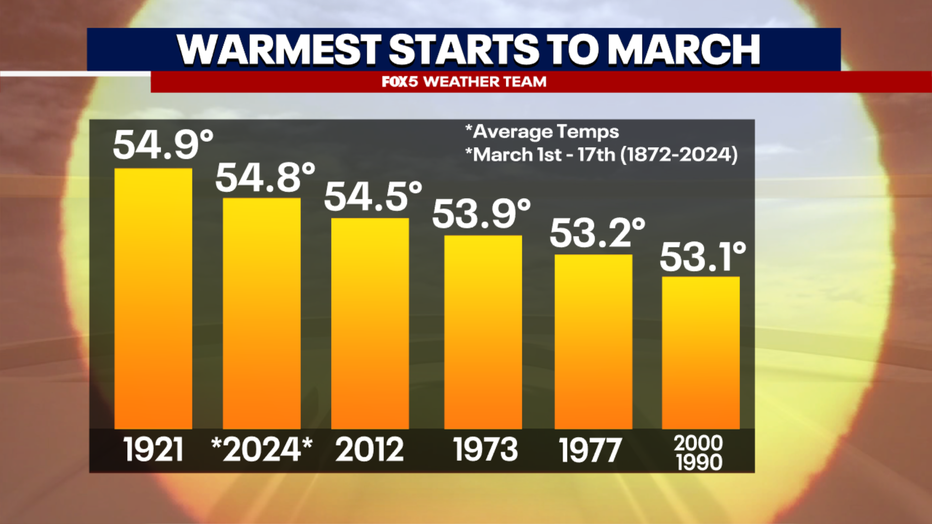Peak Bloom: Here are the best days to see the cherry blossoms
When is the best time to see the Cherry blossoms this week?
FOX 5 meteorologist Mike Thomas delivers the 7-day weather forecast and discusses the best times to go see the cherry blossoms this week.
WASHINGTON - It is almost fitting that one of the warmest winters on record in Washington, D.C. should end with one final early nod to spring, the blooming of the famous Japanese Cherry Trees down at the Tidal Basin.
The National Park Service Office stated that peak bloom officially began on Sunday, March 17, marking the earliest peak bloom in nearly a quarter of a century. The last time was when we hit peak bloom on the same day in 2000.
This year's date is tied for the second-earliest peak bloom on record. In 1990, they bloomed on March 15.
READ MORE: Cherry Blossom Festival kicks off: Here's the history behind DC's iconic blooms
According to the National Park Service, the peak bloom date is defined as the day when 70% of the Yoshino cherry tree blossoms are open.

This comes on the heels of what was tied as the sixth-warmest winter and eighth-warmest February on record.
March has also started on a hot note, with the first half of the month being the second-warmest start on record. D.C. has already seen five days above 70° through the first half of the month, in a month when the entire month typically averages four in total.
READ MORE: Cherry blossoms reach peak bloom after warm weekend
The warmth is largely attributed to well above normal global ocean temperatures, especially in the southern Atlantic and Pacific, as well as a strong El Niño in the central Pacific. With the very warm end to winter, it is no wonder the blossoms got a head start going into the first day of spring on Tuesday.

What are the best days to see the cherry blossoms in DC?
With millions of people expected to flock to the D.C. region to see the cherry blossoms, and the start of the National Cherry Blossom Festival coming up on March 20, what are some of the best days to see the blossoms as far as the weather is concerned?
The sooner, the better, always for some of the brighter colors, and thankfully the weather through the middle of the workweek looks like it will cooperate nicely.
READ MORE: How long do cherry blossoms last? Will peak bloom be affected by cooler temperatures?
While it will not be the 70s of last week that helped the blossoms progress quickly to peak stage, a good amount of sunshine should help battle the cooler temperatures – but longer sleeves are certainly recommended, particularly at the Tidal Basin, where winds tend to blow a little stronger off those cooler waters for a chilly feel.
Wednesday will be the warmest day of this week, with highs in the lower 60s. Though blossom viewers should beware of the threat of a few passing showers in the afternoon.

How will the weather affect the cherry blossoms?
Now that the majority of the blossoms are open, the things that can impact them the most are extreme cold, heavy rain, or particularly strong winds — with the petals becoming more delicate the longer they remain out.
A typical peak bloom lasts between 7-10 days, according to the National Park Service. That length varies depending on how the weather holds up.
As for cold temperatures, we do not see anything cold enough for blossom damage, though a few mornings will get close to freezing. Tuesday, Friday, and Sunday morning will be the coldest days of the week – though the good news is that on all of these mornings, temperatures are expected to stay out of the 20s.
An early spring frost or freeze is what could cause some damage to the blossoms, and we really need to see temperatures dip into the middle to upper 20s for that to occur.
The location of the blossoms, down at the Tidal Basin actually helps this, as their proximity to water typically keeps temperatures up a few degrees compared to other places in the city.

Perhaps a bigger concern about shortening the time of peak bloom would be a late-week storm system, though there are still a lot of questions about it.
READ MORE: DC cherry blossoms: Stumpy to live on in spirit as Tidal Basin project nears
Some weather models hold the storm farther to our south and keep it a weaker storm system, meaning lighter rain and less wind for our region. Some, like the American Model above, strengthen it into an almost late-season nor'easter, and while it will be far too warm for snow, an early spring nor'easter typically comes with heavier rainfall and stronger wind gusts.
This system looks most likely from Friday evening through Saturday afternoon at this time, but the FOX 5 Weather Team will continue to monitor the forecast for you, and update you with the latest throughout the course of the week.
For those heading to see them, enjoy the blossoms and do not forget to share some of your favorite photos with us @fox5dc. We would love to see them!
D.C.'s Cherry Blossoms reach peak bloom
While the calendar says Spring only officially arrives on Tuesday, the peak bloom of the Cherry Blossoms are the beauty sign of Spring we look for in the DMV. It's an annual welcoming event that draws millions to the District each year. Our Gwen Tolbart is at the Tidal Basin enjoying it all.

